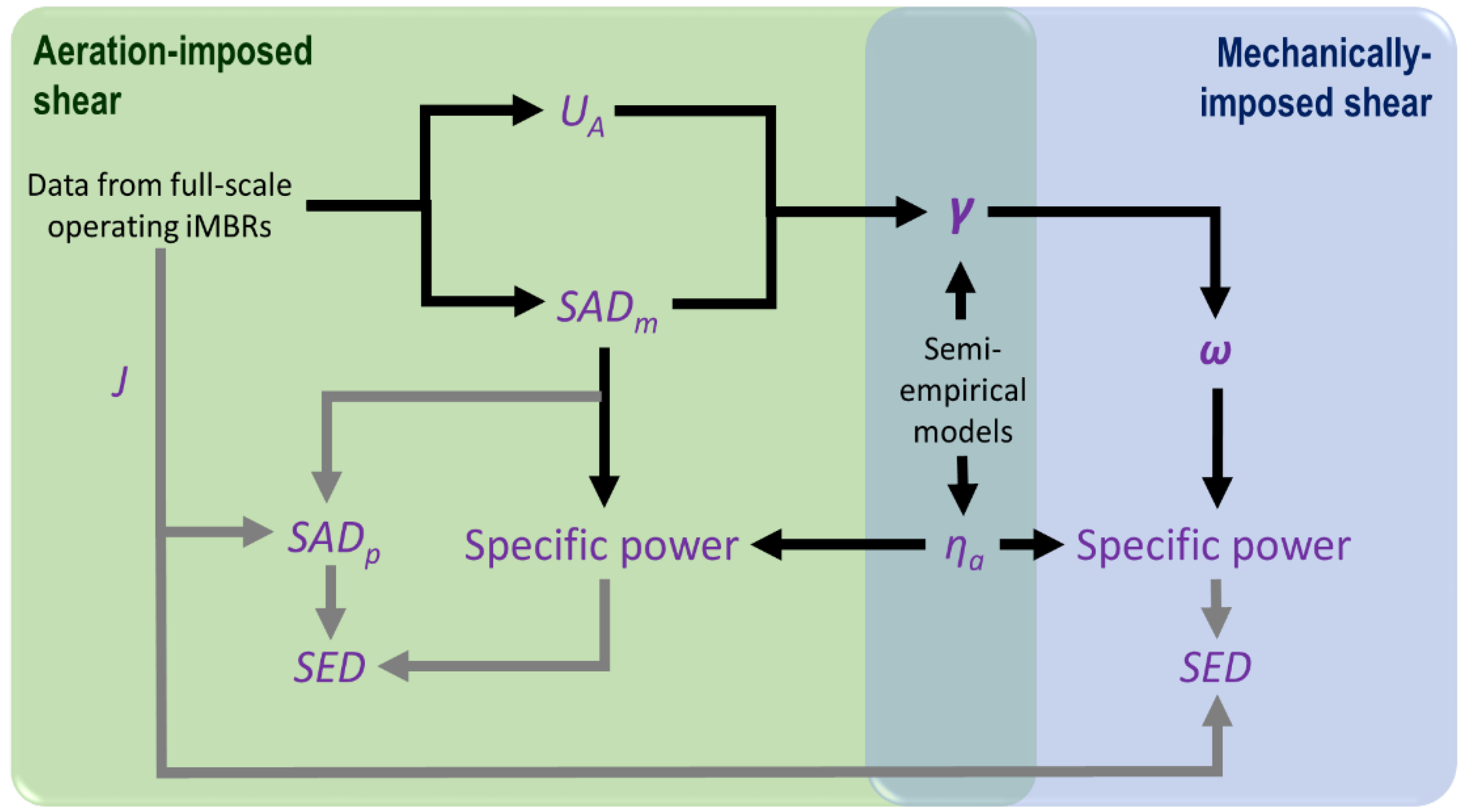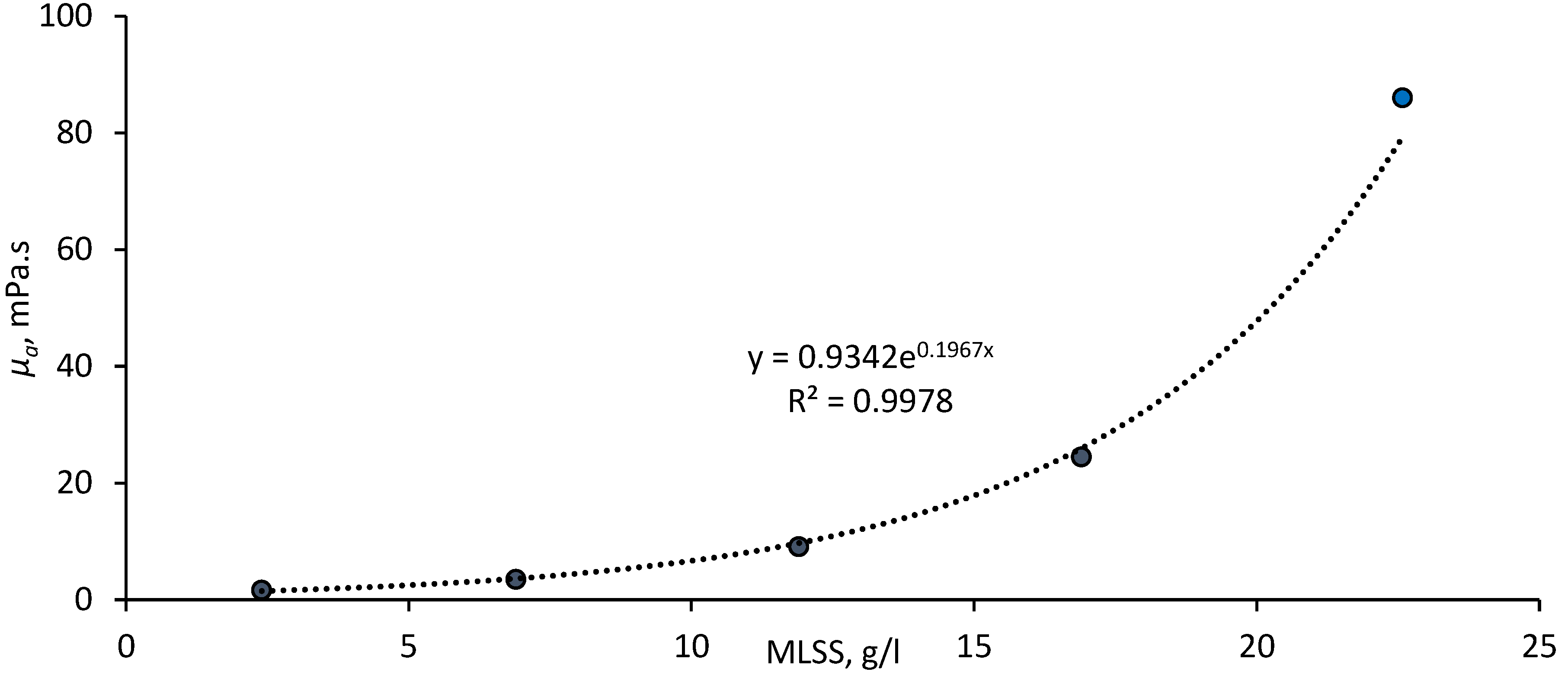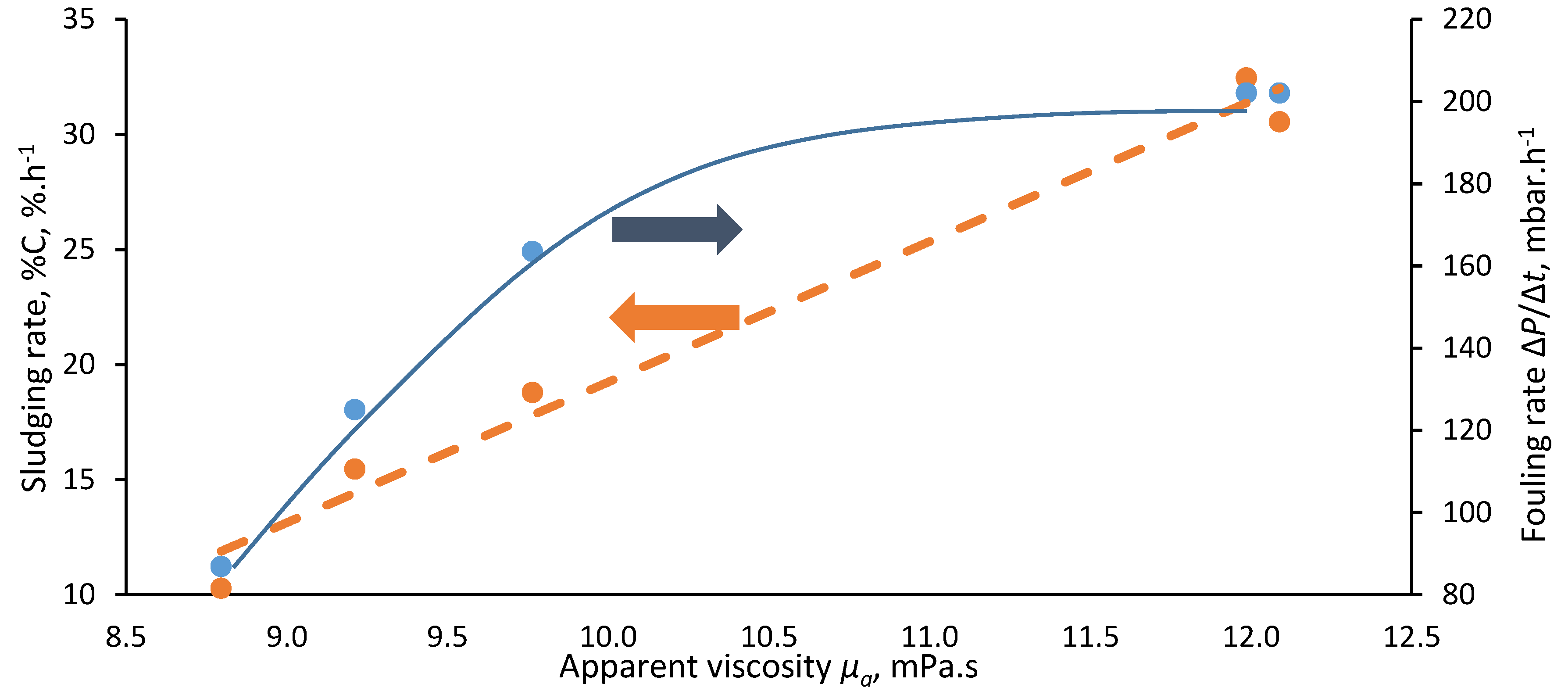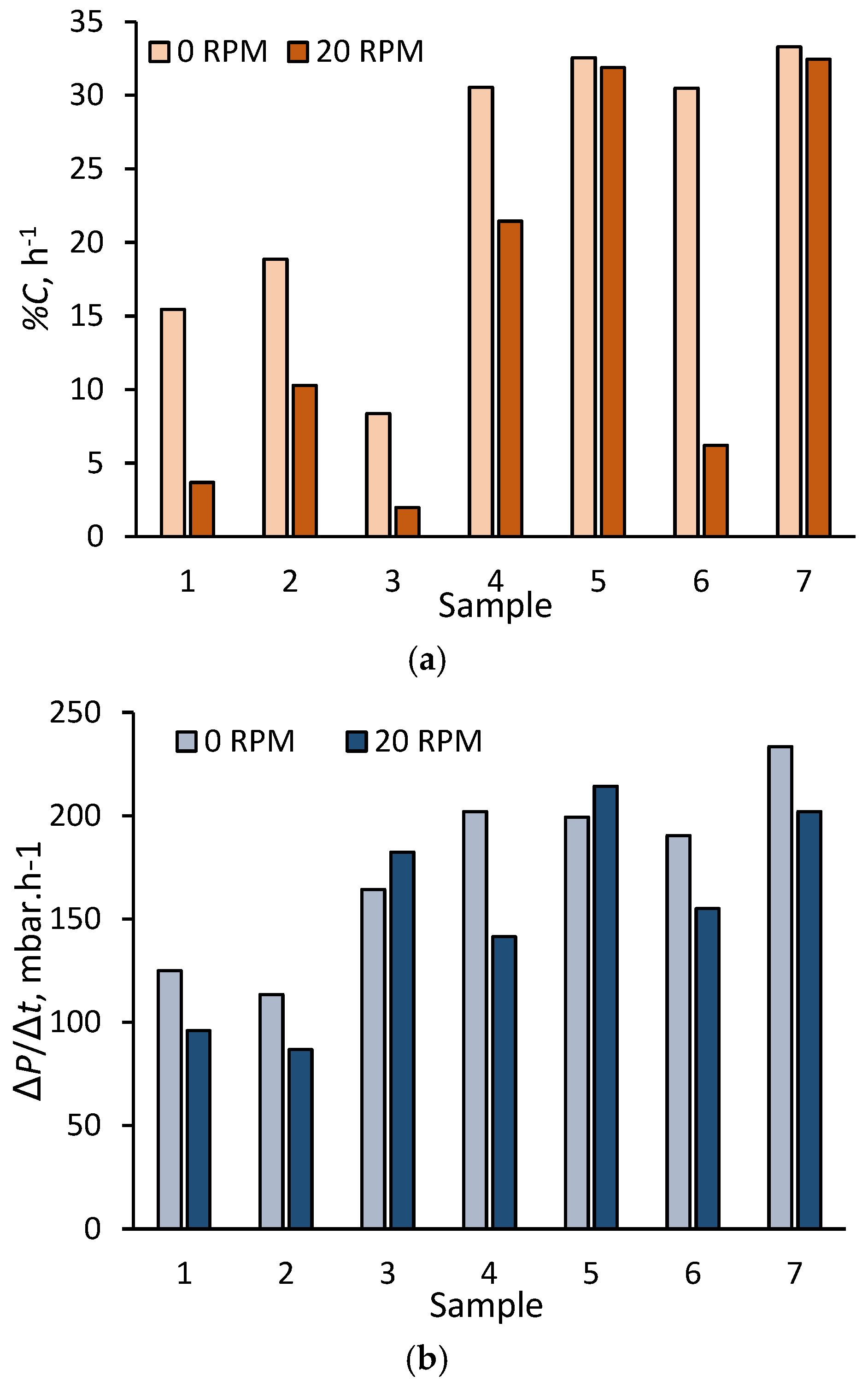The Impact of Mechanically-Imposed Shear on Clogging, Fouling and Energy Demand for an Immersed Membrane Bioreactor
Abstract
:1. Introduction
2. Materials and Methods
- Determining the cycle-averaged shear rate γ in s−1 associated with the reciprocation rate of 20 RPM applied in the study;
- Practical measurement of the apparent viscosity µa associated with this shear rate using the rheometer;
- Applying this viscosity to determine the specific power demand W·m−2, based on the approach of Buzatu et al. [8], as outlined below;
- Calculating the SED, given by the ratio of and the flux J.
3. Results and Discussion
3.1. Practical Measurement
3.2. Determination of Energy Demand, Full-Scale Module
4. Conclusions
- Small but statistically significant beneficial effects recorded from the application of the mechanical shear, manifested by reduced pressure incline and sludging rates, and
- The calculated energy demand associated with this mechanical shear application to be significantly lower than that recently reported for a pilot-scale demonstration.
Author Contributions
Funding
Acknowledgments
Conflicts of Interest
References
- Beier, S.P.; Guerra, M.; Garde, A.; Jonsson, G. Dynamic microfiltration with a vibrating hollow fiber membrane module: Filtration of yeast suspensions. J. Membr. Sci. 2006, 281, 281–287. [Google Scholar] [CrossRef]
- Genkin, G.; Waite, T.D.; Fane, A.G.; Chang, S. The effect of vibration and coagulant addition on the filtration performance of submerged hollow fibre membranes. J. Membr. Sci. 2006, 281, 726–734. [Google Scholar] [CrossRef]
- Jaffrin, M.Y. Dynamic filtration with rotating disks, and rotating and vibrating membranes: An update. Curr. Opin. Chem. Eng. 2012, 1, 171–177. [Google Scholar] [CrossRef]
- Zsirai, T.; Qiblawey, H.; A-Marri, M.J.; Judd, S. The impact of mechanical shear on membrane flux and energy demand. J. Membr. Sci. 2016, 516, 56–63. [Google Scholar] [CrossRef]
- Buzatu, P.; Qiblawey, H.; Nasser, M.S.; Judd, S. Comparative power demand of mechanical and aeration imposed shear in an immersed membrane bioreactor. Water Res. 2017, 126, 208–215. [Google Scholar] [CrossRef] [PubMed]
- Ghosh, R.; Cui, Z.F. Mass transfer in gas-sparged ultrafiltration: Upward slug flow in tubular membranes. J. Membr. Sci. 1999, 162, 91–102. [Google Scholar] [CrossRef]
- Delgado, S.; Villarroel, R.; Gonzalez, E. Effect of the shear intensity on fouling in submerged membrane bioreactor for wastewater treatment. J. Membr. Sci. 2008, 311, 173–181. [Google Scholar] [CrossRef]
- Ho, J.; Smith, S.; Kim, G.D.; Roh, H.K. Performance evaluation of a novel reciprocation membrane bioreactor (rMBR) for enhanced nutrient removal in wastewater treatment: A comparative study. Water Sci. Technol. 2015, 72, 917–927. [Google Scholar] [CrossRef] [PubMed]
- Ho, J.; Smith, S.; Patamasank, J.; Tontcheva, P.; Kim, G.D.; Roh, H.K. Pilot demonstration of energy-efficient membrane bioreactor (MBR) using reciprocating submerged membrane. Water Environ. Res. 2015, 87, 266–273. [Google Scholar] [CrossRef] [PubMed]
- Buzatu, P.; Qiblawey, H.; Odai, A.; Jamaleddin, J.; Nasser, M.S.; Judd, S. Clogging vs. fouling in immersed membrane bioreactors. Water Res. 2018, 144, 46–54. [Google Scholar] [CrossRef] [PubMed]
- American Public Health Association (APHA). American Water Works Association (AWWA) and Water Environment Federation (WEF): Standard Methods for the Examination of Water and Wastewater, 22 nd ed; APHA: Washington, DC, USA, 2012. [Google Scholar]
- Yang, M.; Yu, D.; Liu, M.; Zheng, L.; Zheng, X.; Wei, Y.; Wang, F.; Fan, Y. Optimization of MBR hydrodynamics for cake layer fouling control through CFD simulation and RSM design. Bioresour. Technol. 2017, 227, 102–111. [Google Scholar] [CrossRef] [PubMed]
- Rosenberger, S.; Kubin, K.; Kraume, M. Rheology of activated sludge in membrane bioreactors. Eng. Life Sci. 2002, 2, 269–275. [Google Scholar] [CrossRef]
- Khalili Garakani, A.H.; Mostoufi, N.; Sadeghi, G.; Hosseinzadeh, M.; Fatourechi, M.; Sarrafzadeh, M.H.; Mehrnia, M.R. Comparison between different models for rheological characterisation of activated sludge. Iran. J. Environ. Health Sci. Eng. 2011, 8, 255–264. [Google Scholar]
- Eshtiaghi, N.; Markis, F.; Yap, S.D.; Baudez, J.-C.; Slatter, P. Rheological characterisation of municipal sludge: A review. Water Res. 2013, 47, 5493–5510. [Google Scholar] [CrossRef] [PubMed]
- Krzeminski, P.; Van Der Graaf, J.H.J.M.; Van Lier, J.B. Specific energy consumption of membrane bioreactor (MBR) for sewage treatment. Water Sci. Technol. 2012, 65, 380–392. [Google Scholar] [CrossRef] [PubMed]
- Krzeminski, P.; Leverette, L.; Malamis, S.; Katsou, E. Membrane bioreactors—A review on recent developments in energy reduction, fouling control, novel configurations, LCA and market prospects. J. Membr. Sci. 2017, 527, 207–227. [Google Scholar] [CrossRef]
- Judd, S. Industrial MBRs; Judd & Judd: Cranfield, UK, 2014. [Google Scholar]
- Ginzburg, B. LEAPmbr Process Design. In Proceedings of the MEA UFMBR Workshop for ITPs, Abu Dhabi, UAE, 4–7 November 2013. [Google Scholar]
- Tao, G.; Htoo, C.; Phua, K.M.; Chua, S.C.; Wah, Y.L.; Ooi, K.E.; Seah, H. Biosorption and low energy step-feed membrane bioreactor for water and resource recovery. Presented at the IWA Congress 2018, Tokyo, Japan, 16–21 September 2018. [Google Scholar]






| Parameter | Sludging Rate Data | Fouling Rate Data | ||
|---|---|---|---|---|
| 20 RPM | 0 RPM | 20 RPM | 0 RPM | |
| Mean | 12.6 | 22.1 | 146.0 | 165.4 |
| Variance | 138 | 84.2 | 2418 | 1243 |
| Observations | 6 | 7 | 6 | 7 |
| Pooled variance | 109 | 1777 | ||
| Hypothesized mean difference | 0 | 0 | ||
| Degrees of freedom | 11 | 11 | ||
| t Stat | −1.65 | −0.829 | ||
| P(T <= t) one-tail | 0.063 | 0.212 | ||
| t Critical one-tail | 1.80 | 1.80 | ||
| P(T <= t) two-tail | 0.127 | 0.425 | ||
| t Critical two-tail | 2.20 | 2.20 | ||
| Parameter | Units | Bench-Scale | Full-Scale |
|---|---|---|---|
| Frequency | RPM | 20 | 20 |
| γ | s−1 | 4.9 | 22.2 |
| Amplitude | m | 0.022 | 0.1 |
| ηa | mPa·s | 153 | 56.4 |
| P | W·m−2 | 0.00839 | 0.07263 |
| J | LMH | 15 | 15 |
| Motor efficiency | % | 60% | 60% |
| SED | kWh·m−3 | 0.00093 | 0.00807 |
| Parameter | Unit | Ho et al. [8,9] | This Study |
|---|---|---|---|
| Design and operation | |||
| Membrane area | m2 | 45 | 0.1 |
| Membrane length | m | 1.3 | 0.316 |
| TMP | kPa | <20 | <60 |
| Amplitude | mm | 38 to 57 | 100 |
| Reciprocation frequency | Hz | 0.38 to 0.53 | 0.33 |
| RPM | 23 to 32 | 20 | |
| Specific power demand | W·m−2 | 1.55 | 0.073 a |
| Experimental outputs | |||
| Flux (J) range | L·m−2·h−1 or LMH | 20 to 40 | 15 |
| Permeability | LMH·bar−1 | 200 to 300 | 25 to 180 |
| SED (/J) | kWh·m−3 | 0.04 to 0.09 | 0.0081 b |
| Motor efficiency | - | 71% | 60% |
© 2018 by the authors. Licensee MDPI, Basel, Switzerland. This article is an open access article distributed under the terms and conditions of the Creative Commons Attribution (CC BY) license (http://creativecommons.org/licenses/by/4.0/).
Share and Cite
Judd, S.; Odai, A.; Buzatu, P.; Qiblawey, H. The Impact of Mechanically-Imposed Shear on Clogging, Fouling and Energy Demand for an Immersed Membrane Bioreactor. Membranes 2018, 8, 104. https://doi.org/10.3390/membranes8040104
Judd S, Odai A, Buzatu P, Qiblawey H. The Impact of Mechanically-Imposed Shear on Clogging, Fouling and Energy Demand for an Immersed Membrane Bioreactor. Membranes. 2018; 8(4):104. https://doi.org/10.3390/membranes8040104
Chicago/Turabian StyleJudd, Simon, Albert Odai, Pompilia Buzatu, and Hazim Qiblawey. 2018. "The Impact of Mechanically-Imposed Shear on Clogging, Fouling and Energy Demand for an Immersed Membrane Bioreactor" Membranes 8, no. 4: 104. https://doi.org/10.3390/membranes8040104
APA StyleJudd, S., Odai, A., Buzatu, P., & Qiblawey, H. (2018). The Impact of Mechanically-Imposed Shear on Clogging, Fouling and Energy Demand for an Immersed Membrane Bioreactor. Membranes, 8(4), 104. https://doi.org/10.3390/membranes8040104






